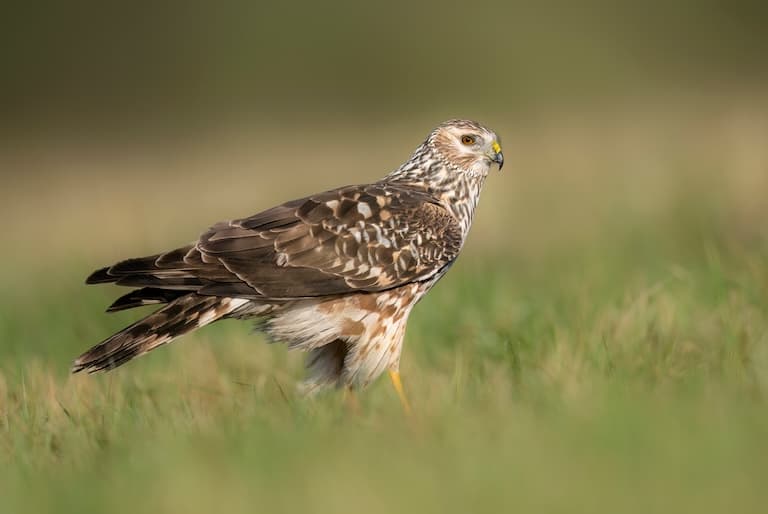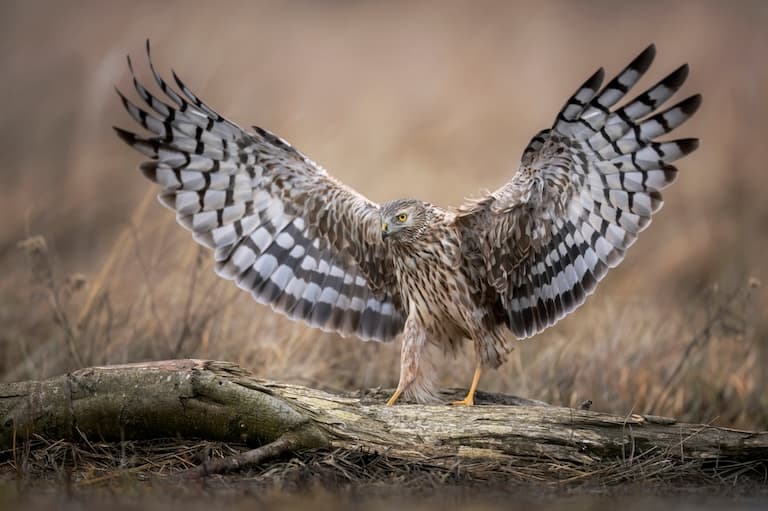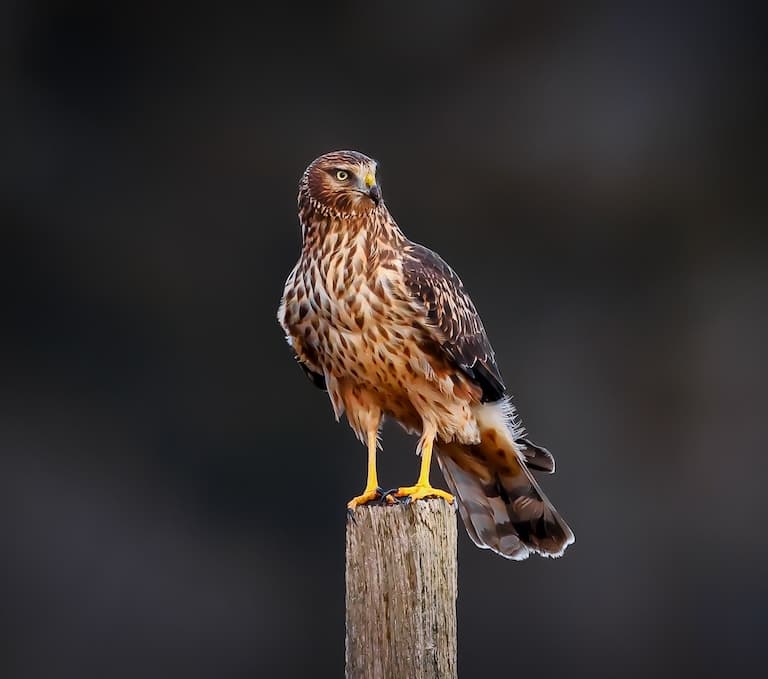Hen Harrier Profile
It seems like almost everyone’s tried their hand at a Harrier variant over the years. Hawker Sidley’s 1960s GR series gave way to the British Aerospace set of very charismatic Sea Harriers that were so formidable during the Falklands War.
BA also teamed up with McDonnell Douglas to make the Harrier sequel: Harrier II, VTOL Boogaloo.
But all of these efforts were an exercise in futility – an attempt to improve on perfection, because the OG Circus brand harrier was, and still is, the true masterpiece of airborne lethality.
The Hen Harrier, Circus cyaneus, is the bird that gave the genus its name, and no amount of VIFFing by naked apes in aluminium tubes is going to beat that.

Hen Harrier Facts Overview
| Habitat: | Open areas, such as fields, meadows, marshes, prairies, and steppe |
| Location: | Eurasia, North-west Africa |
| Lifespan: | Around 16 years |
| Size: | Between 45 and 50 cm (18 to 20 in) long |
| Weight: | 390 to 600 grams (1 to 1.3lbs) |
| Colour: | Males are grey with white bellies, females are brown |
| Diet: | Mostly small birds and mammals, some snakes, frogs |
| Predators: | Crows, ravens, dogs, foxes, other raptors |
| Top Speed: | Not listed |
| No. of Species: | 1 |
| Conservation Status: | Least Concern |
Hen Harriers are the harriers that give harriers their name. Despite this, they’re hawks, from a sister genus to Accipiter, and therefore well worthy of their reputation.
These are some of the most agile of the raptors and they show it off yearly in ritual courtship displays, and daily, in their highly successful hunts.
Local population declines are concerning, but barely make a dent in the species as a whole, as this bird has a tremendous range across Eurasia, benefitting from exposed, grassy plains.
Interesting Hen Harrier Facts
1. They’re true hawks
The Accipitriformes order is one of the largest groups of raptorial birds there is, and certainly the largest order of diurnal raptors that exists (Owls are a close competitor, with a similar number of species, but they are very stupid animals, so we can safely overlook them for now).
The word Accipitriformes basically means “Hawk-shaped” which is pretty inaccurate for a lot of members, like the Andean condor and the harpy eagle, but it gives the general gist of things.
Of the families in this order, the most hawk-shaped are the Accipitridae, but this family is also a jumble of birds that contains eagles and kites, so to get even more hawk-shaped, we go a step more specific to the subfamily Accipitrinae.
This is the subfamily of “true” hawks and has 11 genera of hawks, one of which is the Accipiter, or hawk genus, and the hawkiest hawks there are. Just a gentle step to the side of Accipiter is the genus Circus, which is where we find the harriers.
The genus name stems from the Greek kirkos, referencing the circular flight of one particular species: the hen harrier.

2. The Harrier Skydance
It’s not just circles that these impressive birds are known for, they exhibit outstanding agility in the third dimension, too.
During mating season, males will engage in courtship displays to show off how cool and how totally worth mating with they are, and they do this by rocketing up to great heights and then spiralling or somersaulting back down again.
This is an unmistakable demonstration of strength, stamina and agility and if he wins over a female, he’ll repeat it up to two more times if so inclined.
Then, he will have between one and three mates to defend, which he will do so aggressively until they have fledged chicks. 1 2
3. They’re vocal
Mating rituals involve some calling, but it’s around the nest that these harriers are most noisy. Rapid clicks and squeaks are common in this context, and the birds have a repertoire that covers distress, excitement and the celebration of a successful hunt, too.
Like many birds, baby harriers make an annoying “begging call” which becomes more insistent as they age.
Their hearing is also impressive, aided by an adaptation more commonly seen in owls. 3
4. They have owl features
Looking at the face of a hen harrier alone, it would be easy to mistake it for an owl. This species has a rounded dish for a face, much like their nocturnal counterparts, and for the same reason.
This dish captures sound and channels it towards the ears, which helps the bird hunt by sound alone. And the hen harriers are exceptional hunters. 4

5. They’re killers
Northern harriers are active during the day and spend much of their time hunting. Small mammals make up the overwhelming majority of their diets, and in some populations, this is entirely made up of voles.
Snakes, frogs, other birds and insects are occasionally preyed upon but in general, this bird is a small mammal specialist, and the satellite dish for a head helps them pick out scurrying sounds from within the grassland habitats they patrol.
Being this cool and successful comes at a steep cost though, and it seems like there are a lot of dangers leading up to adulthood for the hen harrier.
6. They have a lot of enemies
The longest-lived hen harrier was 16 and a half. This is not common, though, and even in adulthood, 8 years is asking a lot. But to get to this age, hen harriers have to overcome threats from a plethora of egg and chick predators, including foxes, owls, dogs, cats, badgers, crows and snakes.
And it’s not only wild animals to look out for, humans persecute hen harriers in the UK more than any other bird of prey, by people who want to kill grouse and don’t want anything else to do it before they can. 5
7. They’re in decline
Illegal killing and habitat conversion across its range have led to the species decline over recent decades.
However, this is a tremendously widespread bird and its global population isn’t declining enough to worry about. Local populations, such as those in the UK and Ireland, are of far greater concern, especially in relation to the illegal killing of the birds. 6

Hen Harrier Fact-File Summary
Scientific Classification
| Kingdom: | Animalia |
| Phylum: | Chordata |
| Class: | Aves |
| Order: | Accipitriformes |
| Family: | Accipitridae |
| Genus: | Circus |
| Species: | cyaneus |
Fact Sources & References
- RSPB (2018), “Hen Harrier Skydance”, YouTube.
- “The Hen Harrier is a rare ground-nesting bird-of-prey”, Hen Harrier Project.
- Brian Limas, “Circus cyaneus northern harrier”, IUCN Red List.
- Patrick Barkham (2019), “Patrick Seven in 10 hen harriers in UK study likely illegally killed”, The Guardian.
- “Hen harrier”, Scottish Wildlife Trust.
- “Hen Harrier”, IUCN Red List.
